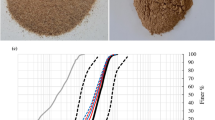Abstract
This paper deals with the compositional and textural characteristics determining open metastable structures in the pleistocenic sand outcropping in the Agrigento district (Sicily). The aim of the study was to individuate the bonding types occurring between grains that could generate matric suction phenomena. The composition and microfabric were characterised by means of granulometry, porosimetry, permeability, optical and ESEM-EDS microscopy, thermogravimetry and XR diffractometry, electric conductivity, and ionic chromatography. The data thus acquired show that the skeleton of the sand is constituted mostly by bioclasts and microfossils, calcite and quartz monocrystalline grains. Moreover, assemblages of silt and clay minerals are interposed among them. Cementation is generally absent even at the sites of contact between grains. Porosity is due mainly to interparticle voids. The spatial arrangement of sand, silt and limey grains, the pore geometry, volume and size distribution and network connectivity allow both capillary condensation and effective capillary transport of water. It appears that bonding is due mainly to capillary forces related to the texture and to the type of pores rather than being ruled by composition.


















Similar content being viewed by others
References
Aisa (2004) Associazione italiana per lo studio delle argille: Argille e minerali della argilla Analisi di materiali argillosi per diffrazioni di raggi X e microscopia elettronica a scansione. Teoria ed applicazioni Ed. Saverio Fiore ISBN: 88-75220069
Alonso EE, Gens A, Hight DW (1987) Special problem soils, General Report. In: Proceedings of 9th European Conference on Soil Mechanics and Foundation Engineering, vol 3. Dublin, pp 1087–1146
Barden L, Mcgown A, Collins K (1973) The collapse mechanism in partly saturated soil. Eng Geol 7(1):49–60
Bell FG, De Bruyn IA (1997) Sensitive, expansive, dispersive and collapsive soils. Bull Int Assoc Eng Geol 56:19–38
Burland JB (1964) Effective stresses in partly saturated soils. Discussion of: soil aspects of effective stress in saturated and partly saturated soils. Geotechnique 14:64–68
Camuffo D (1998) Microclimate for cultural heritage. Elsevier, Padova
Clemence SP, Finbarr AO (1981) Design considerations for collapsible soils. J Geotech Eng Div ASCE 107:305–317
Collins K, McGown A (1974) The form and function of microfabric features in a variety of natural soils. Geotechnique 24:223–254
Dudley JH (1970) Review of collapsing soils. J Soil Mech Found Div ASCE 96(3):925–947
Ercoli L, Zimbardo M, Nocilla N, Nocilla A, Ponzoni E (2015) Evaluation of cliff recession in the Valle dei Templi in Agrigento (Sicily). Eng Geol. doi:10.1016/j.enggeo.2015.04.008
Franzen C, Mirwald PW (2004) Moisture content of natural stone: static and dynamic equilibrium with atmospheric humidity. Environ Geol 46:391–401
Fredlund DG, Gan JKM (1995) The collapse mechanism of a soil subjected to one-dimensional loading and wetting. In: Derbyshire E, Dijkstra T, Smalley IJ (eds) Proceedings of NATO Advance Workshop on Genesis and Properties of Collapsible Soils, Loughborough, pp 173–205
Fredlund DG, Rahardjo H (1993) Soil mechanics for unsaturated soils. Wiley, Toronto
Fredlund DG, Xing A (1994) Equation for the soil water characteristic curve. Can Geotech J 31:3
Houston SL, Houston WN, Zapata CE, Lawrence C (2001) Geotechnical engineering practice for collapsible soils. Geotech Geol Eng 19(3–4):333–355
Houston SL, Elkady TY, Houston WN (2003) Post-wetting static and dynamic behavior of collapsible soils. In: Proceedings of International Conference of Problematic Soils, Nottingham, pp 63–71
Jefferson I, Rogers CDF (2012) Collapsible soil. In: Burland C, Skinner, B (eds) Proceedings of ICE Manual of Geotechnical Engineering, ICE Publishing, London, pp 391–411
Jennings JEB, Burland JB (1962) Limitations to the use of effective stresses in partly saturated soils. Geotechnique 12(2):125–144
Larionov AK (1965) Structural characteristics of loess soils for evaluating their constructional properties. In: Proceedings of the 6th International Conference on Soil Mechanics and Foundation Engineering. Montreal, pp 64–68
Lin Z (1995) Variation in collapsibility and strength of loess with age. In: Derbyshire E, Dijkstra T, Smalley IJ (eds) Proceedings of NATO Advance Workshop on Genesis and Properties of Collapsible Soils. Loughborough, pp 247–265
Locat J (1995) On the development of microstructure E. In: Derbyshire E, Dijkstra TA, Smalley IJ (eds) Genesis and properties of collapsible soils. Kluwer, Dordrecht, pp 93–128
Nocilla N, Ercoli L, Zimbardo M, Nocilla A, Meli P, Grado G, Parello G, Presti G (2013) Unsaturated sand in the stability of the cuesta of the Temple of Hera (Agrigento). In: Bilotta E, Flora A, Lirer S, Viggiani C (eds) Geotechnical engineering for the preservation of monuments and historic sites. Taylor and Francis, London
Osipov VI, Sokolov VN (1994) Factors and mechanism of loess collapsibility. In: Derbyshire E, Dijkstra T, Smalley IJ (eds) Proceedings of NATO Advance Workshop on Genesis and Properties of Collapsible Soils. Kluwer, Dordrecht, pp 49–63S
Popescu ME (1986) A comparison between the behavior of swelling and of collapsing soils. Eng Geol 23:145–163
Rogers CDF (1995) Types and distribution of collapsible soils. In: Derbyshire E, Dijkstra T, Smalley IJ (eds) Proceedings of NATO Advance Workshop on Genesis and Properties of Collapsible Soils. Loughborough, pp 1–17
Wentworth CK (1922) A scale of grade and class terms for clastic sediments. J Geol 30:377–392
Zimbardo M, Nocilla N, Evangelista A, Ramondini M, Scotto di Santolo A (2011) Destructuration of typical Sicilian calcarenites. Bull Eng Geol Environ 70:507–515
Acknowledgments
The warmest thanks to Professor Nicola Nocilla, for the valuable contribution of expertise in data processing and interpretation of results. We thank the Parco di Agrigento for allowing the sampling of the sands.
Conflict of interest
The authors declare that they have no conflict of interest.
Ethical approval
This article does not contain any studies with human participants or animals performed by any of the authors.
Informed consent
Informed consent was obtained from all individual participants included in the study.
Author information
Authors and Affiliations
Corresponding author
Rights and permissions
About this article
Cite this article
Zimbardo, M., Ercoli, L. & Megna, B. The open metastable structure of a collapsible sand: fabric and bonding. Bull Eng Geol Environ 75, 125–139 (2016). https://doi.org/10.1007/s10064-015-0752-7
Received:
Accepted:
Published:
Issue Date:
DOI: https://doi.org/10.1007/s10064-015-0752-7




